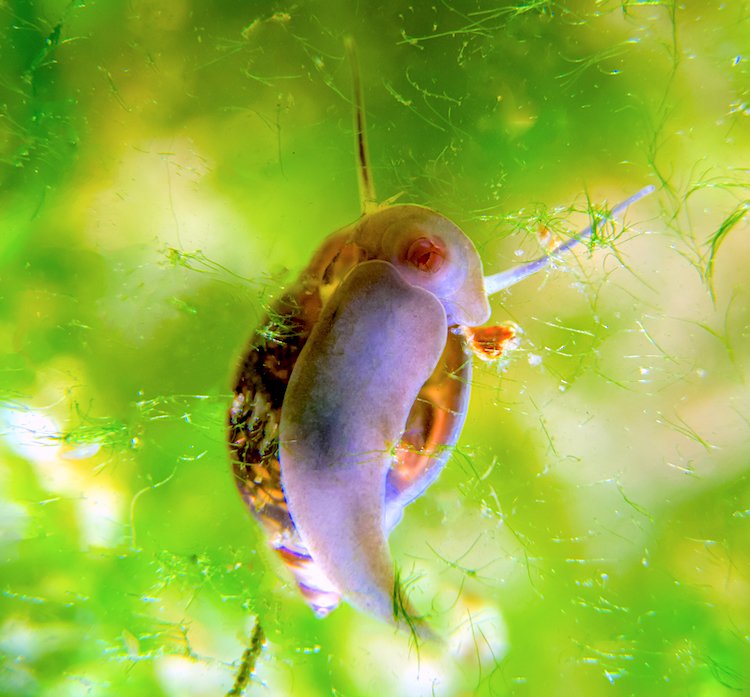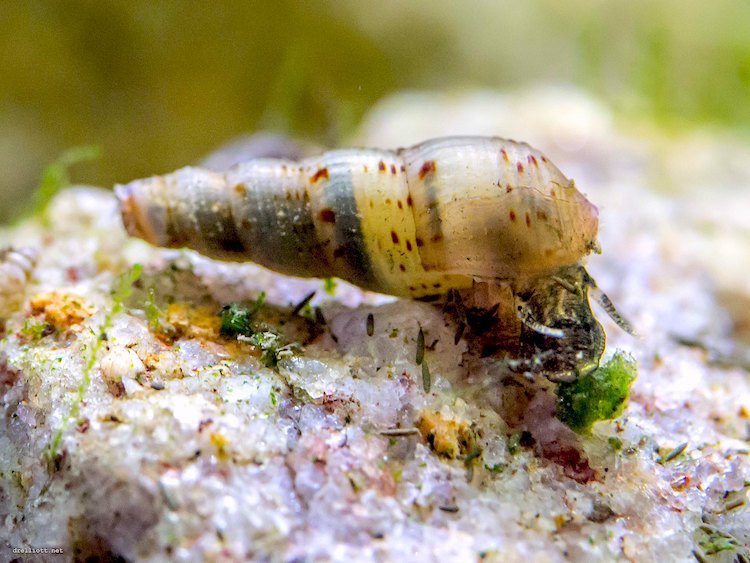
Freshwater snails can be both blessings and curses in the aquarium hobby.
There are snails that consume everything in their path, growing to an enormous size and rapidly outbreeding everything in the tank. And then there’s the select handful of snails that are not only beneficial but also strikingly colorful.
I’d like to share my own experience with 2 types of snails that became long-term inhabitants of my planted aquarium: ramshorn snails and Malaysian trumpet snails.
Ramshorn Snails
The ramshorn, named for the shape of its shell (ram’s horn), was an unexpected hitchhiker on some of the live plants I bought.
These snails had bright pink bodies and golden-brown shells. A number of other color combinations exist, but I loved mine with their cute pink-maroon body color.
Caring for ramshorn snails is pretty easy — you can pretty much let them do their own thing.

How big do ramshorn snails get? The ones I had never grew much more than ½ inch. Keep in mind, though, that there are other species of varying sizes, with one such species capable of reaching 1 inch in size.
There were enough ramshorns in my tank that I never had an exact count of the population. However, because I had a rule of thumb never to overfeed my fish, the snail population thankfully never exploded out of control.
How long do ramshorn snails live? They can live up to 1 year or longer. Honestly, though, I wouldn’t have known. Most of my ramshorn snails looked the same, and I could never keep track of those living or dead. I used to find empty shells now and then during cleaning. These snails make up for their short lifespans by way of prolific breeding.
My ramshorn snails loved fish food and never missed a chance to munch some at feeding time.
One of the cool things they could do was to crawl upside down on the surface of the water just to get extra bits of food.
They never significantly damaged any of the plants — I would just find a hole here or there in leaves. The snails regularly cruised the glass, scraping algae away as part of their diet.
What to Feed Ramshorn Snails
I’d recommend adding some blanched vegetables once or twice a week at most to give them supplemental food.
Zucchini, cucumber and squash will be appreciated. I suggest leaving this extra food overnight and removing whatever is left in the morning.
Ramshorn snails also feed on some of the detritus present in the substrate, which may help reduce nitrates in the water.
The Missouri Department of Conservation notes: “Like other snails, they have a radula, sometimes called a ‘rasping tongue,’ that scrapes rhythmically against the substrate they are crawling across. Algae and other plant materials form the bulk of the diet.”
Water Parameters
Ramshorns are fairly tolerant of many conditions, but there are a few rules to follow if you want them to thrive in your tank:
- Keep the PH neutral, at about 7.0–7.5.
- A safe range for water temperature is 70–80 F, which should allow them to live in most aquariums.
- Keep nitrites at 0.
- Nitrates should be allowed no higher than 40 ppm. While they may help to reduce some detritus that contributes to nitrates, ramshorn snails are still sensitive to higher levels.

Breeding Ramshorn Snails
Ramshorn snails are extremely easy to breed since you really don’t have to do anything other than provide food.
They are egg layers. Sooner or later, you’ll spot egg masses attached to the glass or on the leaves of plants. It’s a clear, gelatinous spot with tiny white dots in the middle. Eventually, they will hatch.
As I mentioned before, I never had an issue with overpopulation, but I believe that was due to my habit of not overfeeding the tank in general. If you discover you have had an explosion of the ramshorn snails, you have several options to try and reduce their numbers.
They are difficult to eradicate from an aquarium once they’ve established themselves, but these suggestions may help:
- You can remove egg masses as soon as you spot them.
- Reduce the amount of food you are giving.
- Remove the snails as you spot them. They are great food for carnivorous fish like loaches.
- Introduce smaller carnivorous fish that will eat them, such as the yoyo loach or Corydoras.
Prevent reintroduction of snails by sterilizing any plants or driftwood before you place them in the tank:
- Soak the plants in 3 parts water to 1 part bleach solution for 1 minute, then thoroughly rinse.
- You can soak driftwood in this solution for a bit longer, but you will need to soak it in fresh water for a while to make sure you’ve washed off the bleach.
Some of your plants might be damaged by the bleach, but this is a surefire method to kill snails and their eggs.

Malaysian Trumpet Snails
Caring for Malaysian trumpet snails isn’t any more difficult than caring for ramshorn snails. They are less competitive for food and peaceful to other invertebrates and fish in community tanks.
Also called red-rimmed melania, Malaysian trumpet snails are known for their conical, spiraled shell, which is usually beige with darker patterns. The variety I kept had black bodies with white specks, which stood in stark contrast to the brighter ramshorns.
How big do Malaysian trumpet snails get? On average, they grow to about ½ inch, but I know at least a couple of the ones in my aquarium were a full 1 inch.
How long do Malaysian trumpet snails live? They can live about 1 year, or even up to 1.5 years old, if conditions are right.
The ones I had always stuck close to the substrate, as that was their main source of food. An interesting fact about Malaysian trumpet snails is that they actively burrow through the substrate consuming detritus and aerating it, which benefits the health of the aquarium. As they do this, they manage not to disturb any plants’ root systems.
I never experienced a population boom with these snails, and they took their time to build their numbers. They were unique-looking snails, and my tank definitely benefited from their presence.
“Algae and excess fish food are scourges of most aquariums, and both of these are relished by trumpet snails,” according to Tropical Fish Hobbyist. “It is much healthier for wasted food to be converted into more snails as opposed to extra nitrogenous waste for your biofilter load.”

What to Feed Malaysian Trumpet Snails
Although mine fed very well on the detritus hidden in the gravel substrate, they loved any extra sinking pellets I’d throw in from time to time. Malaysian trumpet snails must have a good sense of taste and smell because as soon as the food hit the bottom, they were homing in on it.
Consider offering supplemental foods, such as sinking pellets or the occasional blanched veggie slices, once a week at most. If you have a huge number of snails and almost no detritus left for them to feed on, you can offer more food for them. Otherwise, I’d leave them to do their jobs cleaning the substrate.
Water Parameters
- PH can range from 6.5 to 8.0 with a water hardness of about 7 dH.
- Water temperature should remain around 75 F. The range of 70–80 F is safe.
- Nitrite should always remain at 0.
- Nitrates should be no higher than 40 ppm.
- Keep ammonia at 0 — these snails are very sensitive to ammonia spikes.
Breeding Malaysian Trumpet Snails
Breeding Malaysian trumpet snails will occur more quickly in warmer water, as it seems to help raise fertility.
It would be wise to start with just a few snails at first and let them slowly propagate themselves little by little. This is one way to avoid being overrun with snails.
An interesting fact about Malaysian trumpet snails is that they are not egg layers like most snails. They give birth to live young, which are just miniature versions of the adults. This process increases the survival rate of their offspring.
Some of the babies I remember seeing must have been less than 1 millimeter in size.
Just remember, don’t overfeed, or these snails will breed faster. As long as you hold fast to that rule, you shouldn’t be overrun by more snails than you can handle.
If you do end up with more Malaysian trumpet snails than you want, plenty of aquarists will actually pay you for them.
Check out this video for more on ramshorn and Malaysian trumpet snails:

Where to Get Ramshorn or Malaysian Trumpet Snails
These days, you can conveniently order many of these small snails online in package deals for home delivery.
Sometimes you can find color morphs of the species you may be searching for. These colorful varieties may be a bit pricey, but they are well worth the cost if you’re looking to add some color to your tank.
Local fish shops are another avenue that you can use to buy snails. You might need to ask for them specifically, as most stores might not actually stock them.
I’ve found that snails are often already living in aquariums with fish, and not specifically listed for sale anywhere. Just ask someone at the shop and they should be able to point you in the right direction. They may be able to order some if they don’t have any in stock.
As it so happens, many fish keepers end up with snails by accident when they buy live plants. Snails either have laid a clutch of eggs in the plant or are simply hitching a ride themselves.
Final Thoughts
Whatever snail species you decide to add to your aquarium, whether for color or as janitors, you will no doubt enjoy watching their antics.
Although some can be frustrating to get rid of, others will pull their weight in the benefits they offer. I know I’ve enjoyed watching the snails I’ve had over the years. They are surprisingly busy little creatures!
References
- Wiegert, Joshua. “Aquarium Snails: What to Keep and What to Avoid.” Chewy. 2018. https://petcentral.chewy.com/aquarium-snails-what-to-keep-and-what-to-avoid/.
- “Ramshorn Snails: Gyraulus, Helisoma, Menetus, Micromenetus, Planorbula spp.” Missouri Department of Conservation. https://nature.mdc.mo.gov/discover-nature/field-guide/ramshorn-snails.
- Lorenz, Tom. “Taming the Tenacious Trumpet Snail.” Tropical Fish Hobbyist. Aug. 2009. http://www.tfhmagazine.com/freshwater/feature-articles/taming-the-tenacious-trumpet-snail.htm.
- Freshwater and Marine Aquarium 29, no. 1–3 (2006). https://books.google.com/books?newbks=1&newbks_redir=0&id=NuQbAQAAIAAJ&dq=%22malaysian+trumpet+snail%22.


